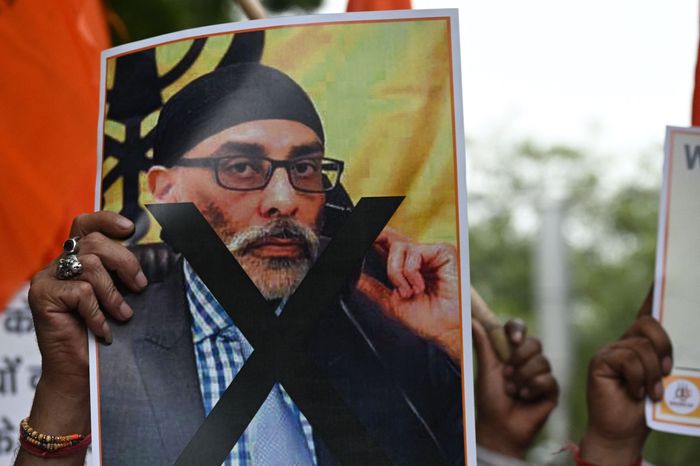U.S. prosecutors said on Wednesday that an Indian government employee, identifying himself as a “senior field officer” in charge of intelligence, had ordered the May murder of a Sikh separatist in New York City. The court filing, which comes after identical accusations made by Canadian officials last month, intensifies scrutiny of India’s espionage services.
Prosecutors claim that the government employee, who was not identified in the charge brought before a federal court in Manhattan, enlisted the help of an Indian citizen named Nikhil Gupta to hire a hit man to carry out the assassination, which was thwarted by American authorities.
Although the victim’s identity was not disclosed in the court filing, top Biden administration officials claim that Gurpatwant Singh Pannun, general counsel of the Sikhs for Justice organization in New York, which supports the establishment of an independent Sikh state within India called Khalistan, was the intended victim.
The Biden administration sent its top two intelligence officials to New Delhi to demand that the Indian government look into and hold those responsible accountable for the attempted assassination on American soil, according to senior administration officials. The allegation that the Indian government was involved in the attempt has strained relations between the two nations.
Director of National Intelligence Avril Haines and CIA Director William J. Burns both visited India in October and August of last year, according to the officials, who, like everyone else questioned for this story, spoke on condition of anonymity due to the delicacy of the subject.
The Justice Department announced on Wednesday that the unidentified Indian government worker consented to pay $100,000 to a fictitious hit guy who was actually an undercover American law enforcement agent as part of an arrangement arranged by Gupta. Gupta instructed the alleged hit man to carry out the New York murder on June 19, one day after Sikh separatist Hardeep Singh Nijjar was killed in Canada, citing the fact that both Sikhs were on the same list of targets, according to U.S. authorities.
Canadian Prime Minister Justin Trudeau made a shocking disclosure in September, stating that there were “credible allegations” that New Delhi was responsible for the murder. On both cases, U.S. law enforcement and its Canadian colleagues are collaborating closely, according to officials.
The allegations against Gupta, who was detained in the Czech Republic while awaiting extradition to the US, are based on a minimal indictment that was submitted in the middle of June and made public in July.
Arindam Bagchi, the spokesperson for the Indian Foreign Ministry, stated in a statement on Wednesday that India “takes… seriously” the information sent by the US and that earlier this month it established a “high-level inquiry committee” to look into the matter. It made no mention of whether the Indian government was involved in any assassination plot or not.
The Financial Times was the first to report on the assassination attempt being foiled and the existence of an indictment.
After learning of the thwarted scheme in late July, the administration made a determined attempt to bring up the issue with senior Indian government officials. During a meeting in a different nation in the region at the beginning of August, national security advisor Jake Sullivan personally expressed his concerns to his counterpart, Ajit Doval.
A senior administration source stated, “He emphasized that India needed to look into [the plot] and hold those involved, accountable, and that the United States required an assurance that this would not happen again.
After attending the U.N. General Assembly in September, Minister of External Affairs S. Jaishankar visited Washington, where Secretary of State Antony Blinken and Sullivan brought up the matter once more. Moreover, officials alleged that Haines traveled to India in October to provide the government with information on the plot to support its investigation.
Burns proceeded to India a week after Sullivan’s meeting to convey the same message to his counterpart, Ravi Sinha. In a September meeting with Prime Minister Narendra Modi at the Group of 20 summit, President Biden himself emphasized the gravity of the situation, saying that “the potential repercussions for the bilateral relationship were similar threats to persist.”
When the claims were made public last week, National Security Council spokesperson Adrienne Watson stated, “Indian counterparts expressed surprise and concern.” This was in response to the revelation that the plan had failed. “They declared that such actions were not within their policy.”
Concern over what they perceive to be an unprecedented campaign of transnational persecution by India of Sikh separatists in North America has grown among activists and some U.S. lawmakers.
A member of the American Sikh Congressional Caucus, Rep. Eric Swalwell (D-Calif.) stated on X in September that he was “concerned by reports that India’s government is targeting Sikh activists abroad” and that he would collaborate with state and federal representatives to guarantee that the Sikh community was protected.
The majority of Sikhs worldwide reside in Punjab, an Indian state. Despite this, there is little evidence of widespread pro-separatist sentiment within the state. Modi’s government has repeatedly claimed that Sikh extremists aided by Pakistan have instigated unrest and carried out terrorist attacks inside India.
